Seashell: Difference between revisions
m BOT - Reverted edits by 68.42.2.125 {possible vandalism} to revision #182948135 by "VoABot II". |
No edit summary |
||
| Line 11: | Line 11: | ||
Despite this variety of shells, it is quite often the case that only the shells of marine [[mollusc]]s, (spelled "mollusks" in the USA), are meant when the word seashells is used. |
Despite this variety of shells, it is quite often the case that only the shells of marine [[mollusc]]s, (spelled "mollusks" in the USA), are meant when the word seashells is used. |
||
== |
==Mollusk shells== |
||
{{main|Gastropod shell}} |
{{main|Gastropod shell}} |
||
{{main|Bivalve shell}} |
{{main|Bivalve shell}} |
||
Revision as of 03:00, 24 January 2008

A seashell is the common name for a hard, protective outer layer created by a marine organism or sea creature. In addition to seashells, there are also several different types of non-marine animal shell in the natural world.
Seashells are very often found in beach drift, which is deposited along strandlines on beaches. These shells are often washed up empty and clean, the animal having already died, and the soft parts having rotted away or having been eaten by other creatures. This is how most shells are found by beachcombers, and collecting these shells is a harmless hobby. However, the majority of seashells which are offered for sale commercially have been collected live, killed and cleaned specifically for the commercial trade, and this type of exploitation can sometimes have a strong negative impact on rarer species, and on local ecosystems.
The kind of seashells which are perhaps most familiar, and most commonly encountered, both in the wild and for sale as decorative objects, are the external shells of marine mollusks. These are usually primarily composed of calcium carbonate, in the form of calcite or aragonite crystallised out in an organic matrix. Calcium carbonate in mollusk shells can take different crystalline forms, one being nacre, otherwise known as mother of pearl.
Other kinds of sea animals have exoskeletons or shells which may after death be found in beach drift and picked up by beachcombers, and these include other invertebrate remains such as crab shells, horseshoe crab shells, and sea urchin tests.
Despite this variety of shells, it is quite often the case that only the shells of marine molluscs, (spelled "mollusks" in the USA), are meant when the word seashells is used.
Mollusk shells
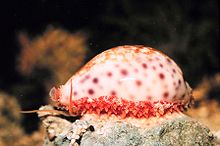
The majority of shell-forming molluscs belong to two classes: Gastropoda (univalves, or snails) and Bivalvia (bivalves or clams, oysters, scallops, etc). There are, in addition, three other classes of mollusks which routinely create a shell, and those are: Scaphopoda (tusk shells), Polyplacophora (chitons, which have eight articulating shelly plates), and Monoplacophora (single-shelled chiton-like animals which live in very deep water, and which superficially resemble minute limpets.
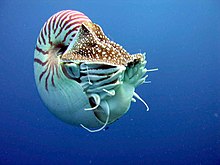
Nautiluses are the only extant cephalopods which have an external shell, although octopuses, cuttlefish and squid (especially Spirula spirula), have small internal shells. Females of the octopus genus Argonauta secrete a specialised paper-thin eggcase in which they partially reside, and this is popularly regarded as a shell, although it is not attached to the body of the animal.
Malacology, the scientific study of molluscs as living organisms, has a branch devoted to shells, called conchology - although it should be noted that these terms used to be, and to a minor extent still are, used interchangeably, even by scientists (this is more common in Europe).
Creating the shell
In those mollusks which have a shell, the shell grows gradually over the lifetime of the mollusc by the addition of calcium carbonate to the leading edge or opening, and thus the shell gradually becomes longer and wider, in an increasing spiral shape, to better accommodate the growing animal inside. The animal also thickens the shell as it grows, so that the shell stays proportionately strong for its size.

A mollusk shell is formed, repaired and maintained by a part of the anatomy called the mantle. Any injuries to or abnormal conditions of the mantle are usually reflected in the shape and form and even color of the shell. When the animal encounters harsh conditions which limit its food supply, or otherwise cause it to become dormant for a while, the mantle often ceases to produce the shell substance. When conditions improve again and the mantle resumes its task, a "growth line" which extends the entire length of the shell is produced, and the pattern and even the colors on the shell after these dormant periods are sometimes quite different from previous colors and patterns.
Interestingly, within some species of mollusk there is often a surprising degree of variation in the exact shape, pattern, ornamentation, and color of the shell.
Composition of mollusc shells

Shells are composite materials of calcium carbonate, found either as calcite or aragonite and organic macromolecules, mainly proteins and polysaccharides. Shells can have numerous ultrastructural motifs, the most common being crossed-lamellar (aragonite), prismatic (aragonite or calcite), homogeneous (aragonite), foliated (aragonite) and nacre (aragonite). Although not the most common, the nacre is the most studied layer. Shells of the class Polyplacophora are made of aragonite
Mollusc shells (especially those formed by marine species) are very durable and outlast the otherwise soft-bodied animals that produce them by a very long time (sometimes thousands of years). They fossilize easily, and fossil mollusc shells date all the way back to the Cambrian period. Large amounts of shells sometimes form sediment, and over geological time spans can become compressed into limestone deposits.
Mother of pearl and pearl formation
Nacre, also known as mother of pearl, is an important part of the shell structure in many gastropod and bivalve mollusks especially the more ancient families such as top shells and pearl oysters. Like the other calcareous layers of the shell, the nacre is created by the epithelial cells (formed by the germ layer ectoderm) of the mantle tissue. Mollusk blood is rich in dissolved calcium, and during shell deposition, the calcium is concentrated out from the blood and crystallized as calcium carbonate. Nacre is continually deposited onto the inner surface of the animal's shell (the iridescent nacreous layer or mother of pearl). This is done both as a means to thicken, strengthen and smooth the inner surface of the shell itself and as a defense against parasitic organisms and damaging detritus.
When a mollusc is invaded by a parasite or is irritated by a foreign object that the animal cannot eject, a process known as encystation entombs the offending entity in successive, concentric layers of inner shell material, which in some cases is nacre. This process eventually forms what we call pearls and continues for as long as the mollusk lives. Almost any species of bivalve or gastropod is capable of producing "pearls", even mollusks which have no inner nacreous layer. However, only a few species, such as the famous pearl oysters, can create pearls which are highly prized.
Non-marine mollusks

In fresh water shell-bearing mollusks are represented by families from the orders Unionoida (freshwater mussels) and Veneroida (clams), as well as the class Gastropoda (snails).
The class Gastropoda also includes many land snails, most of which are pulmonates and breathe air. Although the great majority of land snails are small and inconspicuous, the large and highly-colored shells of some tropical species are prized by collectors. In certain tropical islands such as Cuba, or Papua New Guinea, there are almost as many species of land snails as there are of marine. Land snails cannot disperse very easily, so populations frequently become isolated from each other, resulting in situations where adjacent islands, or even adjacent valleys separated by hills or mountains, contain closely-related but clearly separate species of land snails.
Seashell collecting as a hobby
Both the science of studying mollusk shells and the hobby of collecting and classifying them are known as conchology -- the line between professional and amateur enthusiasts is often quite blurry.
Shells of marine molluscs (some of which wash up on beaches or live in the intertidal or sub-tidal zones and are therefore easily found without specialized equipment) are collected by a large number of enthusiasts. Many shell collectors find their own material or are interested in "specimen shells": shells in good condition which come with full scientific collecting data: information including how, when, where, in what habitat, and by whom, they were collected.
In the tropical and sub-tropical areas of the planet, there are far more species of colorful, large, and intertidally-dwelling seashells than there are in the temperate zones and the regions closer to the poles.
Other sea creatures
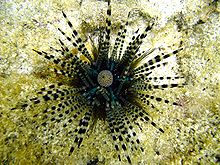
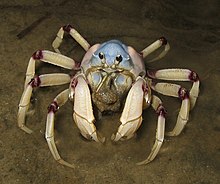
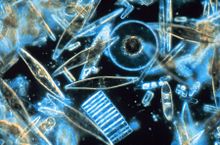
The brachiopods, or lamp shells, superficially resemble clams, but the phylum is completely unrelated to molluscs. Most lines of brachiopods were ended during the Permian-Triassic extinction event, and their ecological niche filled by bivalves.
The construction of the shell-like structures of corals are aided by a symbiotic relationship with a class of algae, zooxanthellae. Typically a coral polyp will harbour particular species of algae, which will photosynthesise and thereby provide energy for the coral and aid in calcification,[1] while living in a safe environment and using the carbon dioxide and nitrogenous waste produced by the polyp. Coral bleaching is a disruption of the balance between polyps and algae, and can lead to the breakdown and death of coral reefs.
Some echinoderms (starfish, sea urchins, sand dollars) and some polychaetes (annelid worms) also have hard exoskeletons. The now-extinct ostracoderms ("shell-skins") were a type of armoured marine fish which flourished in North America and Europe during the Ordovician, Silurian and Devonian geological periods.
Arthropods
Many arthropods have sclerites, or hardened body parts, which form a stiff exoskeleton made up mostly of chitin. In crustaceans, especially those of the class Malacostraca (crabs, shrimp and lobsters, for instance), the plates of the exoskeleton may be fused to form a more or less rigid carapace.
Chelonians
Sea turtles also form a carapace and plastron of bone and cartilage which is developed from their ribs.
Planktons and protists
Plant-like diatoms and animal-like radiolarians are two forms of plankton which form hard silicate shells.
Foraminifera and coccolithophore create shells called "tests" of calcium carbonate.
Shells as decorative items in human culture
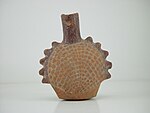
Throughout the history of humanity, shells of many types and from many different kinds of animals have been popular as human adornments. They are often used whole and drilled so that they can be threaded like a bead, or cut into pieces of various shapes.
The uses have including all kinds of pendants, beads, buttons, brooches, rings, and hair combs among other uses.
The Moche culture of ancient Peru worshipped animals and the sea and often depicted shells in their art.[2] Native American used shells for wampum and hair pipes.[3]
Small pieces of colored and iridescent shell have been used to create mosaics and inlays which have been used to decorate larger items such as boxes and furniture. Large numbers of whole seashells, arranged to form patterns, have been used to decorate man-made grottos.
See also
- The Bailey-Matthews Shell Museum
- Seashell surface, a mathematical construct
References
- ^
Madl, P. and Yip, M. (2000). "Field Excursion to Milne Bay Province - Papua New Guinea". Retrieved 2006-03-31.
{{cite web}}: Cite has empty unknown parameter:|accessyear=(help)CS1 maint: multiple names: authors list (link) - ^ Berrin, Katherine & Larco Museum. The Spirit of Ancient Peru:Treasures from the Museo Arqueológico Rafael Larco Herrera. New York: Thames and Hudson, 1997.
- ^ Shell Hair Pipes used in Indian Adornment
